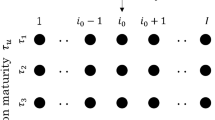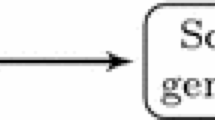Abstract
The mean-Gini framework has been suggested as a robust alternative to the portfolio approach to futures hedging given its optimality under general distributional conditions. However, calculation of the Gini hedge ratio requires estimation of the underlying price distribution. We estimate minimum-Gini hedge ratios using two widely-used estimation procedures, the empirical distribution function method and the kernel method, for three emerging market and three developed market currencies. We find that these methods yield different Gini hedge ratios. These differences increase with risk aversion and are statistically significant for all developed market currencies but only one emerging market currency. In-sample analyses show that the empirical distribution function method is more effective at risk reduction than the kernel method for developed market currencies, whereas the kernel method is superior for emerging market currencies. Post-sample analyses strengthen the superiority of the empirical distribution function method for developed market and, in several cases, for emerging market currencies.
Similar content being viewed by others
References
Azzalini, A., “A Note on the Estimation of a Distribution Function and Quantiles by a Kernel Method.” Biometrika 68, 326–328 (1981).
Baillie, R. and R. Myers, “Bivariate GARCH Estimation of the Optimal Commodity Futures Hedge.” Journal of Applied Econometrics 6, 109–124 (1991).
Cheung, C., C. Kwan and P. Yip, “The Hedging Effectiveness of Options and Futures: A Mean- Gini Approach.” Journal of Futures Markets 10, 61–73 (1984).
Carroll, C., P. Thistle and J. Wei, “The Robustness of Risk-Return Nonlinearities to the Normality Assumption.” Journal of Financial and Quantitative Analysis 27, 419–435 (1984).
Efron, B., “Bootstrap Methods: Another Look at the Jackknife.” The Annals of Statistics 1, 1–26 (1979).
Gagnon, L. and G. Lypny, “The Benefits of Dynamically Hedging the Toronto 35 Stock Index.” Canadian Journal of Administrative Sciences 14, 69–78 (1997).
Ghosh, A., “Hedging with Stock Index Futures: Estimation and Forecasting with Error Correction Model.” Journal of Futures Markets 13, 743–752 (1993).
Ghosh, A., “The Hedging Effectiveness of ECU Futures Contracts: Forecasting Evidence from an Error Correction Model.” The Financial Review 13, 743–752 (1995).
Gini, C., “Variabilita e Mutabilita Contribute Allo Atdio Delle Distribuzioni e Relazioni Statistiche.” StudiEconomico-Giuridici dell’ Univ. di Cagliari 3(2), 1–158 (1912).
Hodgson, A. and J. Okunev, “An Alternative Approach for Determining Hedge Ratios for Futures Contracts.” Journal of Business Finance & Accounting 19, 211–224 (1992).
Jin, Z. and Y. Shao, “On Kernel Estimation of a Multivariate Distribution Function.” Statistics and Probability Letters 41, 163–168 (1999).
Kolb, R. and J. Okunev, “An Empirical Evaluation of the Extended Mean-Gini Coefficient for Futures Hedging.” Journal of Futures Markets 12, 177–186 (1992).
Kolb, R. and J. Okunev, “Utility Maximizing Hedge Ratios in the Extended Mean-Gini Framework.” Journal of Futures Markets 13, 597–609 (1993).
Kroner, K. and J. Sultan, “Time-Varying Distributions and Dynamic Hedging with Foreign Currency Futures.” Journal of Financial and Quantitative Analysis 28, 535–551 (1993).
Lerman, R. and S. Yitzhaki, “A Note on the Calculation and Interpretation of the Gini Index.” Economics Letters 15, 363–368 (1984).
Lien, D., “The Effect of the Cointegration Relationship on Futures Hedging: A Note.” Journal of Futures Markets 16, 773–780 (1996).
Lien, D. and X. Luo, “Estimating the Extended Mean-Gini Coefficient for Futures Hedging.” Journal of Futures Markets 13, 665–676 (1993a).
Lien, D. and X. Luo, “Estimating Multiperiod Hedge Ratios in Cointegrated Markets.” Journal of Futures Markets 13, 909–920 (1993b).
Lien, D. and X. Luo, “Multiperiod Hedging in the Presence of Conditional Heteroskedasticity.” Journal of Futures Markets 13, 665–676 (1994).
Lien, D. and Y. Tse, “Hedging Downside Risk with Futures Contracts.” Applied Financial Economics 10, 163–170 (2000).
Lien, D. and Y. Tse, “Some Recent Developments in Futures Hedging.” Journal of Economic Surveys 16, 357–396 (2002).
Lien, D., Y. Tse and A. Tsui, “Evaluating the Hedging Performance of the Constant-Correlation GARCH Model.” Applied Financial Economics 12, 791–798 (2002).
Myers, R., “Estimating Time-Varying Optimal Hedge Ratios on Futures Markets.” Journal of Futures Markets 11, 39–53 (1991).
Nadaraya, E. A., “Some New Estimates for Distribution Functions.” Theory of Probability and Its Applications 15, 497–500.
Reiss, R. D., “Nonparametric Estimation of Smooth Distribution Functions.” Scandinavian Journal of Statistics 8, 116–119 (1981).
Shalit, H. and S. Yitzhaki, “Mean-Gini Portfolio Theory and the Pricing of Risky Assets.” Journal of Finance 39, 1449–1468 (1984).
Shao, Y. and X. Xiang, “Some Extensions of the Asymptotics of a Kernel Estimator of a Distribution Function.” Statistics and Probability Letters 34, 301–308 (1997).
Silverman, B., Density Estimation for Statistics and Data Analysis. London: Chapman and Hall, 1986.
Sim, A. and R. Zurbruegg, “Optimal Hedge Ratios and Alternative Hedging Strategies in the Presence of Cointegrated Time-Varying Risks.” European Journal of Finance 7, 269–283 (2001).
Wahab M. and M. Lashgari, “Price Dynamics and Error Correction in Stock Index and Stock Index Futures Markets: An Error Correction Approach.” Journal of Futures Markets 13, 711–742 (1993).
Wand, M. and M. Jones, Kernel Smoothing. London: Chapman and Hall 1995.
Wilkinson, K., L. Rose and M. Young, “Comparing the Effectiveness of Traditional and Time-Varying Hedge Ratios Using New Zealand and Australian Debt Futures Contracts.” The Financial Review 34, 79–94 (1999).
Yitzhaki, S. “Stochastic Dominance, Mean-Variance and Gini’s Mean Difference.” American Economic Review 12, 178–185 (1982).
Yitzhaki, S., “On an Extension of the Gini Inequality Index.” International Economic Review 24, 716–728 (1983).
Author information
Authors and Affiliations
Corresponding author
Additional information
JEL Classification: F31, G15
Rights and permissions
About this article
Cite this article
Shaffer, D.R., DeMaskey, A. Currency Hedging Using the Mean-Gini Framework. Rev Quant Finan Acc 25, 125–137 (2005). https://doi.org/10.1007/s11156-005-4245-9
Issue Date:
DOI: https://doi.org/10.1007/s11156-005-4245-9




